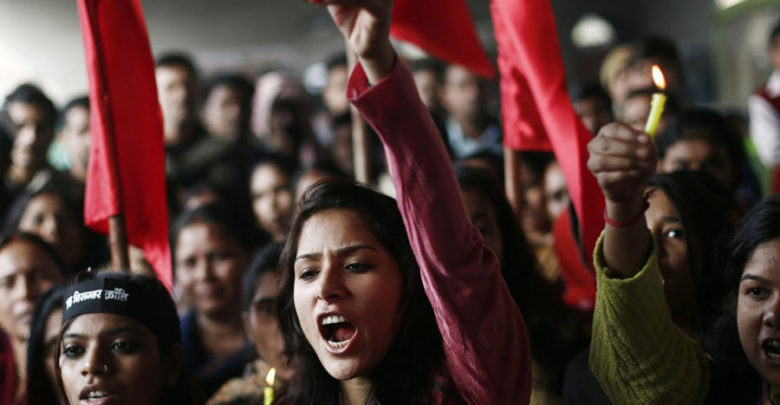Women’s Rights Violations and Abuses in India:

By Qasim Swati (United Kingdom)
Bounded by the Bay of Bengal on the southeast, the Arabian Sea on the southwest, the Indian Ocean on the south, the Republic of India is bordered by Myanmar and Bangladesh to the east, Bhutan, Nepal and China to the north and shares its land borders with Pakistan to the west.
Having the total area of 3,287,263 square kilometres (1,269,219 sq mi), India is the seventh-largest by area, the largest democracy and the second-most populous country of the world with 1,369,699,147 inhabitants/persons, based on the latest United Nations estimates, as of Saturday, July 27, 2019, making it equivalent to 17.74% of the total world population. The Indian soil is enriched with multiculturalism, with 79.80% Hindus, 14.20% Muslims, 2.30% Christians, 1.70% Sikhs, 0.70% Buddhists, 0.40% Jains (believers of Jainism) and 0.90% believers of other religions.
As of 2018, women in India have served on various top positions in the government of India, like the Prime Minister of India, the President of India, the Speaker of the Lok Sabha, and other important posts in different industries, sectors and departments of the country, such as education, health, businesses and all other walks of life. Despite the significant role played by the female population in running the system of the country, women in India still continue to undergo and experience numerous problems, including gender inequality; sexual crimes (like rape, insult to modesty, human trafficking and forced prostitution); domestic violence (such as acid throwing, forced and child marriage, abduction and kidnap); perpetuation of violence against women; female infanticide and sex-selective abortions and murders (like honour killings, dowry deaths, witchcraft-related murders, the practice of sati/suttee or widow-burning), etc.
A huge number of atrocities, violence, and assaults against women in India go unreported and do not get any attention from the media and the public due to numerous reasons and factors, prevalent in the Indian society. However, many women are being killed, persecuted, tortured, exploited and abused in various ways in different parts of India each year for several reasons. For instance, there were 8,172 (2008); 8,383 (2009); 8,391 (2010); 8,618 (2011); 8,233 (2012) and 5,000 (2018) reported dowry deaths, respectively, in various states of India. A dowry death (in South Asia) is the murder or suicide of a married woman caused by a dispute over her dowry (an amount of property or money brought by a bride to her husband on their marriage). “In some cases,’ as argued by Oldenburg (2002), “husbands and in-laws will attempt to extort a greater dowry through continuous harassment and torture, which, sometimes, results in the wife committing suicide, or the exchange of gifts, money, or property upon marriage of a family’s daughter.” [Oldenburg, V.T. (2002). Dowry murder. The imperial origins of a cultural crime. Oxford University Press].
Honour killing is the murder of a relative, especially a girl or a woman, who is perceived to have brought dishonour, shame and disgrace on family, which is another violence perpetrated against women in many parts of India, including Madhya Pradesh, Himachal Pradesh, Jharkhand, Rajasthan, Uttar Pradesh, Bihar and Haryana.
Witchcraft-related murders are another series of women’s rights abuses that still continue in India and put the lives of widows, women from lower castes, or poorer families more at risk in certain parts of the country.
Female infanticide is the intentional and deliberate killing of newborn female children, while sex-selective abortion is the practice of terminating a pregnancy, based upon the predicted sex of the child, but these two discriminatory procedures are also conducted in India for getting rid of female children, particularly by poor families, due to financial, social and other reasons.
Sati/suttee or widow-burning is another heinous and wicked crime against widows, associated with the Indian society and culture for ages. This is a former practice in India whereby a widow threw herself on to her husband’s funeral pyre, or the Hindu custom, no longer legal, (but still continues in some parts of India, in some form), of a woman being burned alive in the same fire as that in which her dead husband’s body is burned. The practice goes back to as early as before the time of the Gupta Empire (an ancient Indian empire existing from the mid-to-late 3rd Century CE to 543 CE). During this period until the official ban on the sati practice, so many widows have lost their lives by sacrificing themselves by sitting atop their dead husbands’ funeral pyres. For instance, it is said that the number of incidents of sati doubled from 378 to 839 only in Bengal between 1815 and 1818.
Another example of widow-burning practice or suttee is given by William Carey [1761 – 1834] (a British Christian missionary, social reformer, translator, Particular Baptist minister and cultural anthropologist) who noted 438 such incidents/cases that had taken place within just 30-mile radius of the capital Calcutta in 1803, notwithstanding the ban on the practice within Calcutta.
However, the Indian Government enacted the Rajasthan Sati Prevention Ordinance, 1987, on 1st October, 1987, following the shocking sati incident of Roop Kanwar (Roopkuvarba Kanwar), an 18-year-old Rajput woman, who was immolated [killed or offered as a sacrifice, especially by burning] at Deorala village of Sikar district in Rajasthan, India, eight months after her marriage, at the death of her husband [Maal Singh Shekhawat].
In spite of such Sati Prevention Act of 1987, there have been some 30 cases of sati or attempted sati from 1943 to 1987 and onwards, as there are some reports of such widow-burning occurrences on various occasions, including some in 2002, 2006 and 2008 as well in different parts of India.
Sexual crimes against the female population in India are also taking place on a large scale. That is why it is believed that ‘India is deemed to be the world’s most dangerous country for sexual abuses and violence against women.’ There were some 21, 467 reported rapes in 2008; 21, 397 in 2009; 22, 172 in 2010; 24, 206 in 2011; 24, 923 in 2012; 34, 707 in 2013; 36, 735 in 2014 and 34, 651 such cases in 2015.
Insult to modesty, human trafficking, and forced prostitution are other sexual crimes, included in sexual violence against women in India.
Likewise, acid throwing, forced and child marriage and such other domestic violence are also different kinds and sorts of women’s rights abuses and violations, carried out on a large number of women in India.
Qasim Swati is a freelance journalist, writer, and human rights activist, based in the UK, and can be reached at https://qasimswati.com or mailto:info@qasimswati.com.


A good and data based article regarding indian practices in society. A contributry approach towards highlighting voilence and abuses in india, but maslow theory of hierarchial needs to be understand that why it occurs, could they think of root causes.
Thanks, Mr. Saeed Khan, for your nice comment on the article.
Everyone know that every single person is violent in India and the rape ratio is very high as well you wrote to many thing in your article that I was unaware and didn’t knew it I got a lot of knowledge from your article thanks for publication but please when you publish your article let me know means send me email thanks
Thanks, Mr. Khan, a lot for your lovely comment on the article.